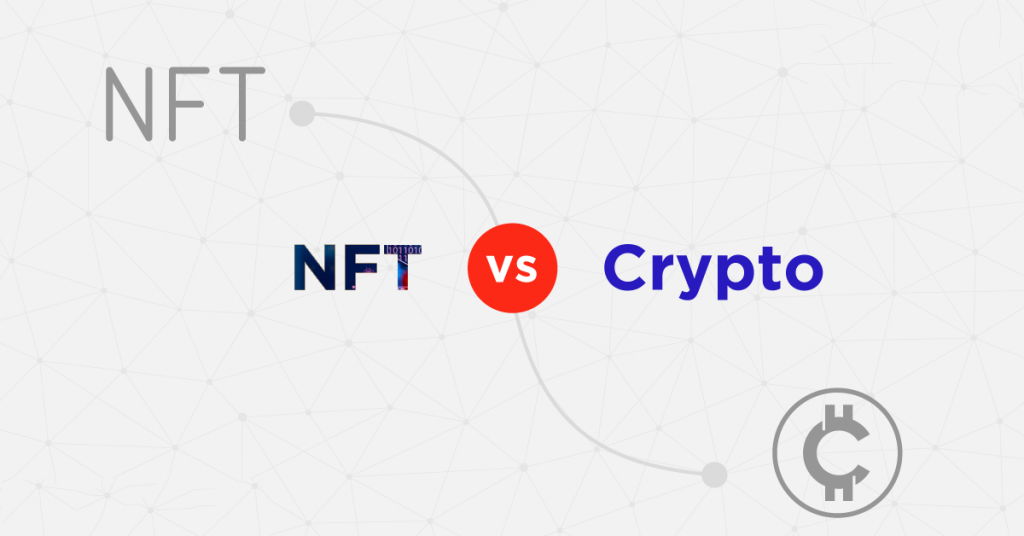Is NFT and Crypto currency have any difference? and What makes it different from each other?
Cryptocurrencies and NFTs are the two most well-known categories of data transactions that blockchain technology has brought about. Although they interact and share some commonalities, they also differ from one another in some very significant ways.
Let us take a look at cryptocurrencies first.
How do Crypto Currencies work?
Digital currencies are known as CryptoCurrencies. The term “Crypto” refers to the fact that these currencies, also known as digital tokens, are secured using a technique called cryptography, making them extremely safe and nearly difficult to duplicate or falsify.
For the sake of an explanation, it’s sufficient to know that cryptocurrencies are essentially a digital form of money. This is why you frequently hear digital tokens named “X-coin.” This security is achieved through a variety of procedures (including encryption algorithms, public-private key pairs, and more), each of which has its own controversies attached to them.
Although there are thousands of cryptocurrencies in existence, across dozens of blockchain platforms, Bitcoin (BTC) and Ethereum (ETH) are the two most well-known ones, each operating within its own unique blockchain system. Since they are the simplest to understand and use as a reference in this article, we’ll stick with BTC and ETH.
On decentralized exchanges like OpenSea and Binance, where you can also purchase NFTs, anyone can buy and sell cryptocurrencies. But before you buy any digital currency, you’ll need to create a crypto wallet because you’ll need somewhere to keep it. Although many people view cryptocurrencies as a trading and investment tool due to their volatility and occasionally skyrocketing values, you can use them to buy things like NFTs (which we’ll discuss next).
The most important thing to realize about cryptocurrencies is that they are fungible, just like fiat money. You wouldn’t mind if someone asked you to trade a five dollar bill you have in your wallet for a five dollar bill they have in their wallet. Your currency is interchangeable; as long as it serves its purpose, any five-dollar bill is equally valid. Exactly like this, cryptocurrencies function. Five ETH in my digital wallet and five ETH in someone else’s digital wallet are equivalent.
Now it’s time for a brief word about security and rules. Transactions are quick and easy because these digital currencies operate on the decentralized blockchain. Without bank intermediaries, there are no fees associated with international transfers, and without government intervention, the currency is not subject to the whims of, say, dictatorial regime leaders. But it also means that you won’t have a third party to compensate you if a transaction goes wrong.
This and other valid concerns about the state of the cryptocurrency industry exist, but it’s important to remember that Web3 isn’t going anywhere any time soon despite its volatility. Simply put, the technology is too valuable and useful. The blockchain-based technology has some very compelling advantages and disadvantages, and like any revolutionary technology in its infancy, these problems are constantly changing. Check out our article on cryptocurrency wallets and how to buy and sell cryptocurrency if you’re interested in learning more about them.
Make sure to do your research and maintain your composure. The media enjoys exaggerating dire predictions. A huge grain of salt should be added to any report or article that claims the world of cryptocurrency is risk-free or the answer to all of the world’s problems. Both viewpoints are extreme, whereas reality is much more complex and interesting.
After gaining a basic understanding of what cryptocurrencies are and how they operate, comparing them to their closely related digital cousin, NFTs, is one of the best ways to learn more about them.
An NFT is what?
Infusible Token is referred to as NFT. These are digital tokens that are similar to cryptocurrencies. NFTs are singular and distinct in contrast to cryptocurrencies, which are fungible, or interchangeable. They exist on the blockchain as cryptographic assets, just like cryptocurrencies.
The comparison that is frequently made here compares the differences between physical money and the distinctive physical goods that people purchase specifically for their distinctiveness. We talked about how cryptocurrencies are fungible; for instance, any amount of ETH in your digital wallet has the exact same value and functionality as an equivalent amount of ETH in another person’s wallet.
Now consider a physical possession you have that is unique to you and special to you. This could be a painting you purchased, a collectible like a baseball card or stamp, a first-edition print of a book you adore, or a work of art that the author has personally signed.
These items are not interchangeable. You would (we hope) decline if someone offered to exchange your first edition, autographed book for a fifth edition reprint without a signature. Despite the fact that they both contain the same words, they cannot be used interchangeably. They are ineluctable.
In this hypothetical thought experiment, apply that idea to an e-book that has a one-of-a-kind digital signature verified by the author and only 25 official copies that are recorded on the blockchain, and you have an NFT. Digital assets can be distinctive and have a monetary value thanks to NFTs. Even if someone downloads or screenshots an NFT that you own, even if it’s just a JPEG, it is still yours. The public blockchain record proves this, and even if someone appears to “steal” your NFT by screenshotting or downloading it, they do not.
The blockchain’s ability to undergo this transformation is what makes it so beautiful. And it has far-reaching effects, one of which is that it enables artists working in all media to receive fair and direct payment for their efforts. Anything that can be digitalized can be converted into an NFT. Songs, GIFs, JPEGs, images, and digital artwork can all be converted into NFTS.
A small amount of psychological modification is necessary to comprehend how NFTs function. If I can screenshot a JPEG or download it to my computer, how can it be unique and mine? Everyone who transitions from Web2 to Web3 eventually asks themselves that question, so it is a legitimate one.
What distinguishes cryptocurrencies from NFTs?
Unique digital assets are NFTs. The digital currency you use to purchase those assets is called cryptocurrency. This is best understood by using a real-world example.
Photographer Cath Simard posted a picture of a lonely Hawaiian road she had taken in October 2017 on her Instagram page. In a matter of hours, the image gained enormous popularity and was shared thousands of times across social media sites—most often without Simard receiving any kind of credit or payment at all.
This disparity perfectly encapsulates many of the issues with Web2. We all know that in Web2, views and clicks almost always equal money. It is not hard to think that at least some money was made off of Simard’s work by those who shared it or the platforms it was shared on, but none of that money went to the artist herself.
Simard, however, made the decision to certify the original image as an NFT using the blockchain. By “certifying” it as the one and only photograph she had taken of that Hawaiian road and uploading it to the blockchain infrastructure, she gave it a unique digital signature that no other copy of the photograph will ever possess.

Simard’s image now had a digital fingerprint, viewable at any time and by anyone in the world, similar to how a painter signs their work and inscribes its edition number. An unchangeable public record that contained the image served as proof of its originality and veracity.
Simard offered for sale the special image NFT. As we’ve already mentioned, you need cryptocurrency in order to buy an NFT. Different cryptocurrencies are used on various blockchains. Simard’s image was minted (produced, verified, and sold) on the Ethereum blockchain for 100 ETH, the fungible currency of that network at the time, or $303,481. Not a bad turnaround for an artist whose work had recently been freely distributed online.
This is an excellent summary of just one advantage of NFTs. Visual artists who previously had to work with intermediary organizations like galleries and only receive a portion of the profits now have a simple and direct way to receive full payment for their contributions.
Another advantage of NFTs is that artists can programme the amount of royalties they receive from secondary sales into the digital contracts that support them. This results in a more sustainable creative economy for the sector because every time the artwork is sold, a portion of the proceeds goes to the original creator.
NFTs are being used by musicians as well. It’s common knowledge that music creators are treated like trash by streaming services like Spotify, YouTube Music, Apple Music, and others. You’ll have a difficult time making any money off of your art unless you’re already a very well-known artist. For instance, Spotify pays artists between $0.003-0.005 for each stream, so you would need about 250 streams to make a dollar. Black Dave, a producer and rapper, is an excellent example of someone who has successfully used NFTs. Black Dave has sold songs and entire albums as NFTs for thousands of dollars at a time.
Importantly, NFTs only have value to the extent of what buyers are willing to pay. Because they already have a following, well-known artists frequently turn their existing work into NFTs and sell them for hundreds of thousands or even millions of dollars at a time. However, a lot of upcoming artists are beginning to use the technology to establish themselves. Unrealistic profits have been made as a result of the explosion of NFT projects supported by novel communities.
In any case, cryptocurrencies and NFTs have altered a wide range of social norms, from how we perceive and value art to how it is produced and disseminated, to how we initially think about the fundamentals of economy, value, and currency. The Web3 is a dynamic, risky environment. However, it cannot be disputed that it is an engaging and motivating one.









